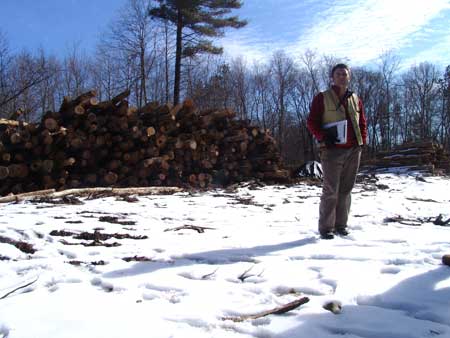Forest Management Vital Role of Providence Water
February 23, 2010

NORTH SCITUATE, R.I. — In the early 1900s, the city of Providence, in its pursuit to create what would become Rhode Island’s largest body of fresh water, started buying barns, sawmills, icehouses, dairy farms, schools, churches and the land upon which these structures sat.
The city ended up taking control of nearly 400 homes, 230-plus barns, about 30 dairy farms, a handful of schools and churches, and a railroad. Some of the 2,000 or so people who were displaced — they were compensated in some fashion for their property loss — fought their evictions, to no avail.
The buildings these people lived in and worked at were quickly torn down. The fields and pastures that weren’t flooded, became nurseries for the 7 million trees, mostly red and white pines, that were planted during the late 1920s and ’30s.
Begun in 1915, the Scituate Reservoir by 1926 had flooded a great natural bowl at the headwaters of the north branch of the Pawtuxet River.
Health issues and increasing demand on the Pawtuxet River prompted the Providence City Council to develop a new water supply system.
Now, eight decades later, two-thirds of the state drinks water from this manmade lake, which forms a long, crooked V across the midsection of Scituate. Some believe this source of clean water allowed metropolitan Providence to grow and for the state to prosper.
It’s also possible that if the reservoir is managed wisely, the state’s largest freshwater tap could run forever.
That responsibility falls to Providence Water, which was established in 1926 and is now an independently operating city department supplying water to about 600,000 Rhode Islanders.
Providence Water, however, manages more than just the 5,000 acres that comprise the Scituate Reservoir and its five smaller tributary reservoirs. The agency is responsible for monitoring the entire 93-square-mile public drinking supply watershed. The agency owns about 25 square miles of that land.
There are 12,500 acres of mostly forested lands in Cranston, Foster, Glocester, Johnston and Scituate that surround the reservoirs and are owned by Providence Water. This mixed oak-pine forest has been heavily shaped by human settlement and changing land uses during the past three and a half centuries.
Thus, forest management plays a vital role in what Providence Water does.
“Forest cover is needed to protect water quality,” said Rob MacMillan, a senior forest supervisor for Providence Water. “We need to continue to regenerate these forestlands. Every time a house, road or field is introduced in the watershed, more pollutants and contaminants follow. Healthy forests provide protection.”
On Saturday, MacMillan and Christopher Riely, a forest supervisor for Providence Water, led a three-hour, 2.5-mile walk-and-talk through some forestland in the northern tip of the watershed.
Watershed lands around the Scituate Reservoir are closed to unauthorized access for security reasons — someone caught trespassing could be fined up to $200 — so Saturday morning’s guided tour, which Providence Water hopes to make a seasonal event, attracted about 30 people.
The primary goal of the agency’s forest management program is to manage forests in the watershed to optimize water production and quality. To properly manage these forestlands, Providence Water allows loggers to bid on harvesting timber from specifically targeted sites.
“You have to plan looking ahead decades,” MacMillan said. “Trees have lifetimes in the hundreds of years, so you better plan ahead.”
Saturday’s tour went through a slice of a 126-acre timber harvest that currently is in hiatus. This harvest, which began last year, is intended to improve growing conditions and forest health in five stands.
The harvest, which will begin again this summer, will primarily remove mixed oak small sawtimber, white pine sawtimber and cordwood of both species, according to the agency’s Saundersville Crossing Timber Harvest Plan.
Besides monitoring well-planned timber harvests that encourage forest regeneration and promote the continued growth of a stand’s remaining trees, Providence Water makes sure the watershed forestlands feature a diverse tree population — mostly white pine, red pine, red oak, white oak, red maple and sugar maple — and manages invasive species — bittersweet, barberry and buckthorn — that hinder the development of a healthy forest.
“Our job is to promote a healthy and resilient forest that can withstand hurricanes, insects, pathogens, gypsy moths and invasive species,” Riely said. “We need to maintain a diverse portfolio of (tree) species and age classes that ensure the watershed remains healthy.”
Categories
Join the Discussion
View CommentsYour support keeps our reporters on the environmental beat.
Reader support is at the core of our nonprofit news model. Together, we can keep the environment in the headlines.
We use cookies to improve your experience and deliver personalized content. View Cookie Settings



